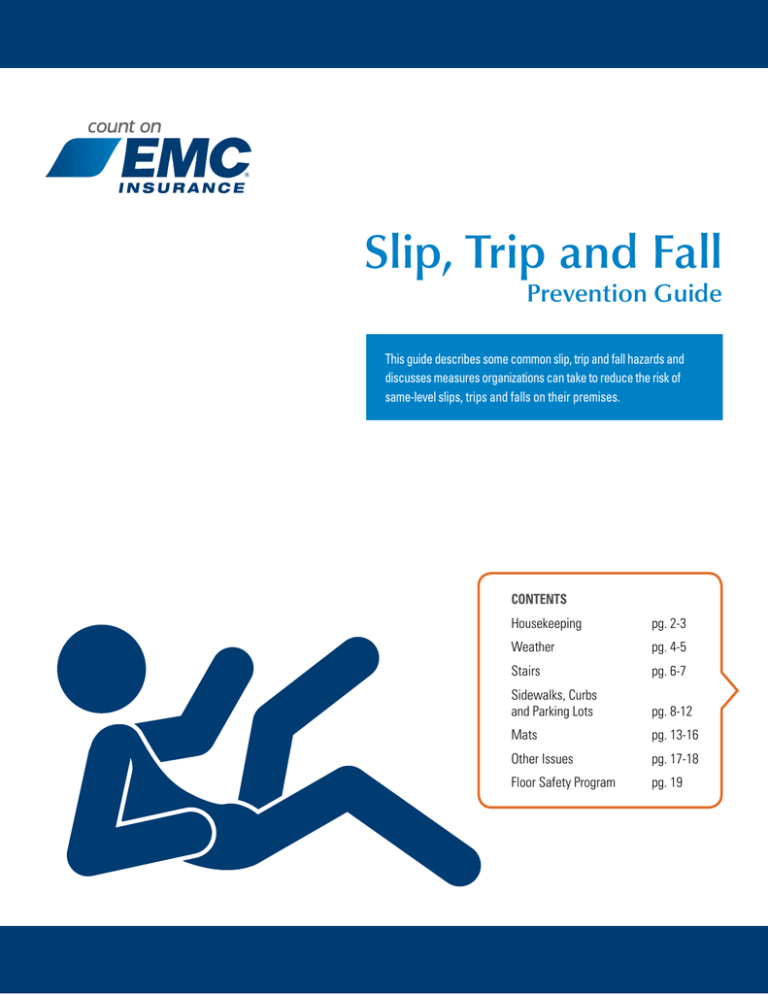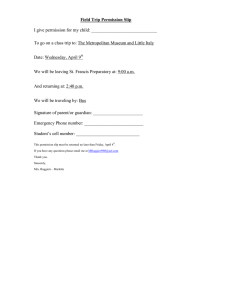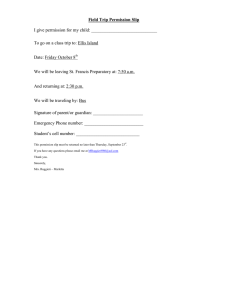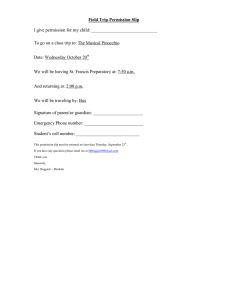
Slip, Trip and Fall
Prevention Guide
This guide describes some common slip, trip and fall hazards and
discusses measures organizations can take to reduce the risk of
same-level slips, trips and falls on their premises.
CONTENTS
Housekeeping
pg. 2-3
Weather
pg. 4-5
Stairs
pg. 6-7
Sidewalks, Curbs
and Parking Lots
pg. 8-12
Mats
pg. 13-16
Other Issues
pg. 17-18
Floor Safety Program
pg. 19
SLIP, TRIP AND FALL PREVENTION GUIDE
Housekeeping
PROBLEM: Cluttered work areas
and debris left on walking surfaces
can lead to slip or trip incidents.
PROBLEM: Objects sit within
or block a walking path or aisle.
PROBLEM: Step stools are not
available, so people tend to stand
on chairs or other unstable objects.
SOLUTION: Create a designated
walking area and mark it off with
distinct tape or paint. Review
housekeeping procedures and
emphasize the importance of
keeping walking surfaces free
of debris.
SOLUTION: Remove the objects to
make a clear walking path.
SOLUTION: Make step stools
and/or stepladders available and
instruct employees on how to use
them. Type 1 or better stools and
ladders that safely support 250 lbs
should be used.
2
Housekeeping
PROBLEM: Sawdust on smooth
concrete creates a slippery surface.
SOLUTION: Use grit strips and
walk-off mats for these areas
and sweep floors frequently.
PROBLEM: Power cords are routed across walkways, creating a trip hazard.
SOLUTION: Additional wall outlets may need to be installed to eliminate the need
to run cords along the floor. Otherwise, use high-visibility cord covers. Tie up
cords that dangle to prevent entanglement.
3
SLIP, TRIP AND FALL PREVENTION GUIDE
Weather
PROBLEM: Parking lots and
sidewalks are not adequately
cleared of snow and ice during
winter months, increasing the
possibility of a slip or fall.
SOLUTION: Clear parking lots
and sidewalks before employees
arrive for work and monitor
them throughout the day during
inclement weather. Place shovels
near doorways to facilitate
shoveling as needed throughout
the day.
PROBLEM: Thin layers of ice or
black ice form when melted snow
refreezes after sundown.
SOLUTION: Perform walkway
audits after the snow melts.
Pile snow to reduce melting into
walkways. Apply coarse sand
or oil absorbent on wet areas
and direct downspouts away
from walkways.
4
PROBLEM: The downspout
discharge is directed across
walking surfaces, contributing
to wet and/or icy conditions.
SOLUTION: Channel the runoff
underneath a walkway.
Weather
PROBLEM: The proper type or
amount of ice melt is not used
on sidewalks and parking lots,
increasing the risk of a slip or fall.
SOLUTION: Check to make sure the correct product and
amount are applied to sidewalks and parking lots according
to the manufacturer’s usage instructions. Some products,
such as those with high concentrations of calcium chloride,
can leave an oily residue that can be tracked throughout the
facility, creating a slippery surface. Make containers of snow
melt or traction aids like kitty litter or oil absorbent available so
employees can spot apply as needed.
TIPS FOR SELECTION AND USE OF ICE MELT:
5
•
Avoid the trap of using too much. Products that include
colorant can help indicate how much to use, preventing
overapplication.
•
The slush created by ice melt should be pushed off the
sidewalk as soon as possible.
•
Magnesium chloride products may have a harmful effect
on concrete. Consider potassium chloride blends instead.
•
Liquid ice melt is not effective when applied to existing
snow/ice. It should be used primarily as a pretreatment
in advance of precipitation.
•
Do not use ice melt on concrete that is less than one
year old.
SLIP, TRIP AND FALL PREVENTION GUIDE
Stairs
PROBLEM: Wooden or
aluminum ramps can be
slippery when wet or snowy.
SOLUTION: Install traction strips on the walking
surfaces of ramps, or apply another slip-resistant
treatment such as lacquer and mineral aggregate.
Consider installing slip-resistant resin ramps when
planning new ramp construction.
PROBLEM: People often shake umbrellas after coming
into a building out of the rain, which may cause a
slip hazard.
SOLUTION: To help reduce water puddles inside
the building, provide umbrella bags for employees
and visitors.
6
Stairs
PROBLEM: Stairs that have no
handrails or insufficient handrails
can increase the risk of a trip
or fall.
PROBLEM: Stair steps with
noncontrasting stair tread can
cause trips and falls.
SOLUTION: Install approved
handrails on at least one side
of steps with four or more stairs.
Handrail construction should be
rounded to enable a firm grip,
which helps prevent falls. Mount
handrails so there is at least a 3-in
clearance between the handrail
and wall.
SOLUTION: Use visibly contrasting
edge treatments on stair steps,
especially on the last step of
a flight of stairs. Nonslip nosing
inserts or friction strips enhance
visibility of steps.
7
PROBLEM: Chipped or deteriorated
stairs create a trip or fall hazard.
SOLUTION: Repair or
replace deteriorated stairs.
Slip-resistant tread covers
can easily be retrofitted to
existing stairs.
SLIP, TRIP AND FALL PREVENTION GUIDE
Sidewalks, Curbs and Parking Lots
PROBLEM: Sidewalk sections that change in elevation more than ½-in create
a tripping hazard, but even a ¼-in elevation can cause trips, especially among
the elderly.
SOLUTION: Repair or replace concrete to provide a smooth transition between
sections. Grinding and mudjacking are typically more economical than replacement.
Provide warning markings or cones until permanent repairs can be made.
8
PROBLEM: Vehicles that overlap
the sidewalk can force pedestrians
to walk on adjacent surfaces, which
may be dangerously uneven.
SOLUTION: Install brightly marked
tire stops where parked vehicles
can potentially reduce the walking
path to less than 3-ft wide.
Sidewalks, Curbs and Parking Lots
PROBLEM: Landscaping borders
and raised edges along walkways
can cause trips, especially when
they are difficult to see or are
located in areas where shortcuts
are anticipated.
PROBLEM: Bushes, shrubs and other foreign objects that infringe upon walking
paths and create possible trip or slip hazards.
SOLUTION: Trim or otherwise contain landscape plantings to minimize their
infringement on walkways. Keep sidewalks clear of all foreign objects such
as pebbles and gravel.
SOLUTION: Adjust landscaping
practices so borders are not
necessary, or place obstacles
in such a way that they prevent
shortcuts.
9
SLIP, TRIP AND FALL PREVENTION GUIDE
Sidewalks, Curbs and Parking Lots
PROBLEM: Potholes in concrete not only create tripping
hazards but can also collect water, which can freeze
and lead to a slip and fall accident.
SOLUTION: Perform routine inspections and repair
potholes as soon as possible. Gravel may be added
as a temporary solution until more permanent repairs
can be made.
PROBLEM: Gravel parking lots with inadequate gravel thickness can
lead to pooling water. During winter months, standing water can
freeze and create a slip hazard.
SOLUTION: Apply additional gravel to high-traffic
areas and areas with thin gravel layers.
10
Sidewalks, Curbs and Parking Lots
PROBLEM: Unpainted curbs or curb ramps along high-traffic sidewalks and other high-traffic areas may be difficult
to see, creating a trip hazard.
SOLUTION: Paint curbs and curb ramps with slip-resistant yellow paint. In addition, consider reworking curb areas by
installing a curb ramp with flared sides and contrasting color.
11
SLIP, TRIP AND FALL PREVENTION GUIDE
Sidewalks, Curbs and Parking Lots
PROBLEM: Gaps between sidewalk sections can catch
heels, creating a tripping hazard. In addition, large gaps
collect water, which can aggravate frost heaving.
SOLUTION: Clean large cracks and fill them with
appropriate caulking material. In some cases, rope
caulking may be necessary to use as a base to keep
the filler material in place.
PROBLEM: Vehicles parked in no-parking areas may obstruct access
to sidewalks and stairs, creating potential trip hazards.
SOLUTION: Check to make sure pavement markings
and signage are adequate and enforce parking rules.
12
Mats
PROBLEM: Overlapping entrance mats create raised humps that can cause people to trip, especially the elderly, who
may have more difficulty seeing the humps.
SOLUTION: Position mats so they create a smooth, level walking surface.
13
SLIP, TRIP AND FALL PREVENTION GUIDE
Mats
PROBLEM: As entrance mats become soiled or
saturated with water, they lose their effectiveness
and allow debris to be tracked into the building.
SOLUTION: Review housekeeping procedures and
emphasize the importance of inspecting and cleaning
mats on a regular basis. Use extractors on large mats
during inclement weather to remove excess moisture.
PROBLEM: Some mats tend to slide or shift out of position when
walked on, which can create a tripping hazard. Mats next to doorways
are of particular concern.
SOLUTION: Inspect mats and reposition as necessary.
When purchasing new mats, make sure they have
slip-resistant backings. Consider mats that are certified
to meet the National Floor Safety Institute standard for
high-traction mats (NFSI B101-C).
14
Mats
PROBLEM: Mats that are worn smooth or are too thin to absorb significant moisture do little good. Other problems
with mats can include curled edges and broken edges.
SOLUTION: Inspect mats regularly and replace when they are worn or damaged.
15
SLIP, TRIP AND FALL PREVENTION GUIDE
Mats
PROBLEM: Areas around drinking fountains and sinks don’t have the correct types of mats to prevent water pooling,
increasing the chance of a slip or fall.
SOLUTION: Set up water-absorbing mats in these areas.
16
Other Issues
PROBLEM: People often wear inadequate footwear for the task being performed.
SOLUTION: Train employees to wear slip-resistant footwear specifically designed for the work environment.
Open heels, spiked heels and flip flops should not be allowed. Since most people walk heel first, the heel area is
usually the first area to wear out and should be inspected regularly.
Employees assigned to work in routinely wet slippery areas (e.g., kitchens) should wear slip-resistant,
rubber-soled footwear.
17
Other Issues
PROBLEM: Water from fountains can shoot onto the
floor, causing pooled water, which is a slip hazard.
SOLUTION: Inspect drinking fountains to help ensure
the water stream does not go beyond the basin.
Install slip-resistant mats along the base of the
drinking fountain.
PROBLEM: Wet floor signs are left up too long, in the way of traffic
or are difficult to see.
SOLUTION: Use wet floor signs to warn pedestrians
of wet floors and remove them when the floor has
dried. If left up continually, people eventually disregard
them. Place wet floor signs in open areas rather than
the middle of doorways or walkways.
18
Floor Safety Program
1.
When installing or replacing floors, choose flooring that provides adequate traction. Ask for documentation from suppliers and perform
friction tests before purchasing.
2.
Check for slip and fall hazards frequently and conduct formal walking surface hazard audits at least annually. Conduct night audits
to check walking surface visibility and lighting levels. Measure floor traction with a slip meter and adjust maintenance procedures
accordingly.
3.
Establish a floor maintenance procedure that indicates the appropriate cleaning chemicals and methods for various types of floors.
Consider using floor treatments designed to increase traction.
4.
Establish a formal snow and ice removal policy. Make sure you are using the correct type of snow or ice melt and that it’s readily
available when and where needed.
5.
Implement a mat safety program and define which types of mats are used when and where. Perform regular mat inspection and
replace worn or damaged mats.
6.
Establish a footwear policy and require that slip-resistant shoes be worn, especially in work areas that are typically wet or slippery.
High-traction overshoes or cleats should be available for those working outdoors in snowy or icy conditions.
7.
Provide other slip prevention tools such as wet floor signs, spill kits and oil absorbent as needed.
19
Learn More
This publication does not list every risk that may be encountered. Management
of every organization should have all its areas inspected for slip, trip and fall
hazards and develop a safety policy catered to the organization’s needs. To
access additional online resources that can help prevent slips, trips and falls,
go to www.emcins.com and select Loss Control.
©Copyright Employers Mutual Casualty Company 2014. All rights reserved. Select images ©Copyright JupiterImages Corporation. RI9124
www.emcins.com |





